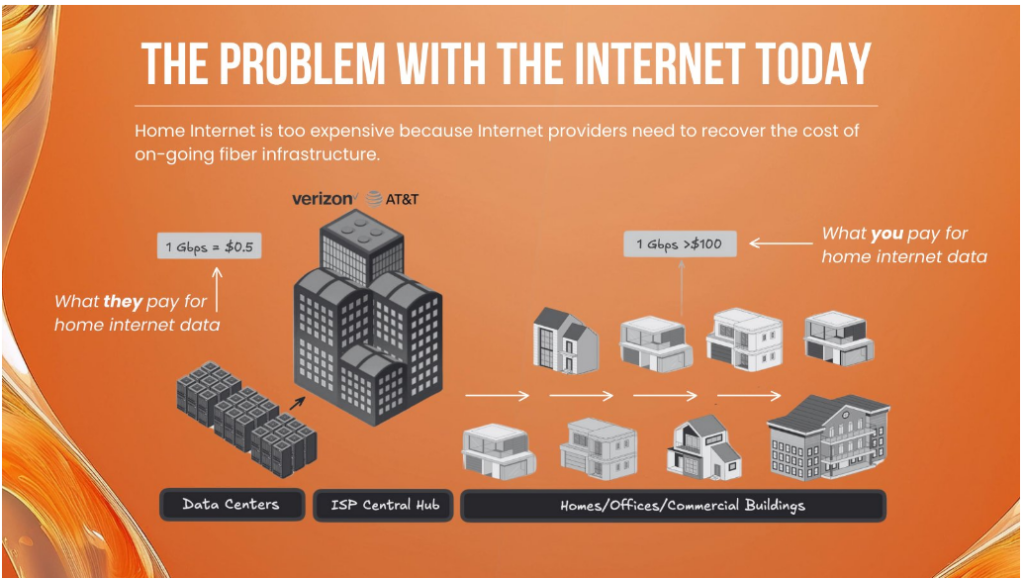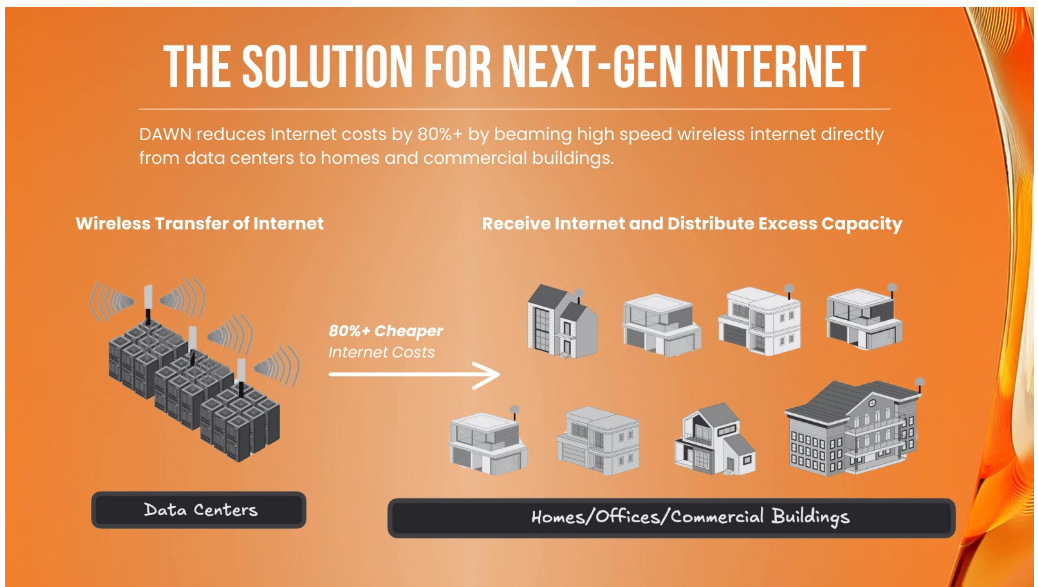Andrena is a pioneering decentralized wireless internet service provider that seeks to transform broadband access through the application of blockchain technology. By utilizing the Solana blockchain, Andrena offers an efficient and cost-effective solution for delivering high-speed internet to underserved and remote communities. The platform operates on a decentralized framework, allowing users to contribute their bandwidth and earn rewards, thereby enhancing internet coverage and reliability.
By employing advanced wireless technologies instead of traditional infrastructure like telephone poles and underground cables, Andrena is able to provide high-speed internet at significantly lower rates. The company utilizes a fiber backbone to distribute internet access across regions through a network of antennas. This innovative approach enables both residential and commercial customers to connect wirelessly to Andrena’s network, facilitating quick activation of services.
About the Project
Vision
Andrena aims to deliver home internet services at significantly lower costs through an innovative delivery model, enhancing accessibility, affordability, and usability like never before. By leveraging advanced wireless technologies, Andrena transforms internet connectivity, making it more attainable for a broader audience.
Problem

Andrena aims to tackle several significant challenges within the broadband internet sector, mainly focusing on high costs and limited accessibility. Traditional internet service providers (ISPs) often impose substantial fees due to the expensive infrastructure associated with copper wires and fiber optics, which consolidates power in the hands of a few dominant players. Consequently, many consumers are confronted with exorbitant prices for internet access, limiting their options and hindering equitable connectivity.
Solution

To combat these challenges, Andrena is developing the Decentralized Autonomous Wireless Network (DAWN) protocol, which allows users to sell their excess internet bandwidth to a network of providers. This decentralized approach reduces reliance on centralized ISPs and enables households to participate actively in the internet ecosystem, similar to how solar panels allow homeowners to generate and sell electricity. By leveraging wireless technology and a decentralized physical infrastructure networking model, Andrena aims to lower costs while expanding coverage, particularly in underserved and remote areas. Additionally, the DAWN protocol incorporates blockchain technology to facilitate secure transactions and incentivize participation without requiring users to invest in their hardware. This innovative model enhances connectivity and empowers individuals by allowing them to contribute to and benefit from the network. Users can earn rewards for sharing their bandwidth, creating a community-driven solution that fosters collaboration and resource sharing.
Product
Andrena provides wireless internet connectivity to buildings through rooftop installations, distributing access via strategically placed wireless points. This innovative approach ensures that customers receive reliable internet service without requiring extensive wiring.
Pricing
Andrena offers internet packages starting at $30 monthly, delivering up to 100 Mbps speeds. The company is committed to accurately representing the speeds customers can expect to receive wirelessly, unlike other providers that often advertise wired speeds achievable only through direct connections to the router. Andrena prioritizes transparency in its advertising, focusing on wireless speeds that reflect actual user experiences.
DAWN would enable customers to take advantage of wireless base stations on rooftops, which, when combined, would provide mesh internet access without the need for a centralized internet provider. Since no wiring needs to be installed, Andrena says it can offer its decentralized broadband service at a lower cost than competitors.
Technology
Utilizing advanced wireless technology, Andrena delivers internet access to buildings by transmitting signals to the rooftop and distributing them throughout the premises, typically without requiring additional hardware. This method contrasts with traditional approaches used by larger ISPs, which depend on telephone poles and underground cables, leading to more time-consuming and costly installations. By directly beaming fast and reliable internet to buildings, Andrena can provide efficient service while offering significant cost savings to customers.
Security
Andrena has meticulously designed its hardware, software, and network infrastructure by incorporating state-of-the-art advancements in network security. When users provide their network information during registration or through their dashboard, a robust firewall operates in the background, ensuring exclusive access to their data and maintaining a secure separation from other users’ information.
Installation

Customers can schedule an installation appointment during the registration process. At the designated time, a member of Andrena’s installation team will arrive at the location to set up the necessary hardware, which typically requires only a single power outlet. The installation process is efficient and usually takes around 30 minutes, allowing customers to gain access to their internet service quickly.
Market Analysis
The market for Decentralized Physical Infrastructure Networks (DePIN) is projected to experience significant growth in the coming years. According to the 2024 DePIN Report, the market size is expected to reach $3.5 trillion by 2028. This forecast highlights the increasing importance of DePIN in integrating blockchain technology with physical infrastructure, facilitating a new sharing economy model within the digital economy 1.
While some estimates place the total addressable market for DePIN at approximately $2.2 trillion, there are suggestions that its true potential could exceed $3.5 trillion, possibly reaching $5 trillion or more. This perspective considers various sectors, such as mobility, energy, and sensor networks, that could significantly contribute to the overall market size.
The growth of DePIN is driven by its ability to provide decentralized solutions for infrastructure needs, allowing individuals and businesses to participate actively in network construction and maintenance. By leveraging existing resources and incentivizing participation through token rewards, DePIN aims to enhance efficiency and reduce costs associated with traditional infrastructure models. As the demand for innovative digital solutions increases, the DePIN sector is well-positioned for substantial expansion soon.
Competitors –
Andrena and Helium Network are critical players in the decentralized wireless internet sector but differ significantly in their approaches and target markets. Andrena focuses on providing affordable broadband to underserved residential areas, utilizing its Decentralized Autonomous Wireless Network (DAWN) protocol, which allows users to sell excess bandwidth through rooftop installations. With competitive pricing starting at $30 per month for up to 50 Mbps, Andrena aims to enhance connectivity in multi-dwelling units without requiring extensive installation. In contrast, Helium Network operates a decentralized network of hotspots that offer LoRaWAN and 5G connectivity, rewarding users with cryptocurrency (HNT) for hosting these hotspots. While Helium initially targeted IoT applications, it has expanded into consumer mobile services and boasts a more extensive user base and broader geographic coverage. Both companies leverage innovative technologies to disrupt traditional ISPs, but Andrena focuses more on residential broadband, while Helium offers a versatile solution for various connectivity needs.
Traction
Andrena operates in multiple states across the United States. The company has successfully established connections in 10,000 households in 10 different states and is experiencing rapid expansion, indicative of the high demand for its services. This widespread adoption underscores Andrena’s strong market position and potential for continued growth and success in the future. Andrena aims to expand its service to over 3 million households at launch and plans to grow its subscriber base significantly through the DAWN protocol. The company partners with real estate owners and property managers to deliver services, providing free connectivity to shared spaces in luxury properties and enhancing community access.
DAWN is currently operating in a testnet environment before launching on Solana.
Investors

Andrena has successfully raised a total of $38 million in funding, including $15 million from a Series A round led by Dragonfly Capital. Other notable investors include CMT Digital, Castle Island Ventures, Wintermute Ventures, 6th Man Ventures, and ParaFi. Following this funding round, the company is valued at approximately $100 million.
Team
The team behind Andrena is led by Neil Chatterjee, the co-founder and CEO, who has a background in engineering and previously built a wireless network at Princeton University. His experience with data-sharing applications inspired the concept of Andrena, focusing on empowering households to share bandwidth and reduce internet costs. Alongside him, James Smits serves as the COO, overseeing operations and service delivery, while Michael Weiss is the CTO, leading technological development. The team also includes Anthony Ontiveros, who contributes to strategic initiatives. Collectively, they bring a wealth of experience in technology and business, aiming to revolutionize broadband access through innovative solutions like the Decentralized Autonomous Wireless Network (DAWN) protocol. This protocol enables users to participate in the network by contributing bandwidth and earning rewards, fostering a community-driven approach to internet connectivity.
Conclusion
Andrena is well-positioned for substantial growth in the broadband market because of its decentralized infrastructure and innovative technology. The company aims to disrupt traditional ISP models, focusing on affordability and accessibility to provide valuable services to underserved communities. Andrena envisions making internet connectivity accessible and affordable for everyone, leveraging its early mover advantage to establish itself as a leading project with a compelling value proposition. Backed by significant investment from notable investors, Andrena’s commitment to innovation and cost-effectiveness distinguishes it as a prominent player in the market, poised for continued growth and success.
| Fundamental Analysis | |||||
| Max score | Options | Score | |||
| Problem | 10 | Significant, long-term problem | 9 | ||
| Solution | 10 | Distinct, defensible solution | 9 | ||
| Market Size | 10 | Large market, significant growth potential | 8.5 | ||
| Competitors | 10 | Uncontested market space, first-mover advantage | 10 | ||
| Use case | 10 | Use case with good potential | 8.5 | ||
| Current Traction | 10 | Early traction, user engagement starting to grow | 6 | ||
| Unit Economics | 5 | Unit economics currently negative, no clear path to profitability | 1 | ||
| Tokenomics | 10 | Basic token strategy, potential for improvement | 7 | ||
| Product Roadmap | 5 | Basic roadmap, lacks detail or innovative features | 2 | ||
| Business Model | 10 | Proven business model with clear path to profitability | 9 | ||
| Go-to-Market Strategy | 5 | Basic GTM strategy, lacks detail or differentiation | 2 | ||
| Community | 5 | Big, strong and active community | 5 | ||
| Regulatory Risks | 5 | Minimal regulatory risk, strong mitigation and adaptability | 5 | ||
| Total Score | 78.10% | ||||





